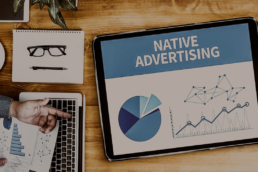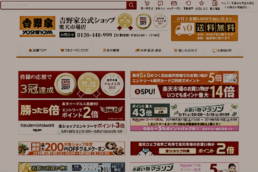Business Focus: Native Advertising, cos’è e la sua importanza, anche in Giappone
Continuiamo con la nostra rubrica Business Focus e oggi trattiamo di Native Advertising. Ne avete mai sentito parlare?
Native Advertising: cos’è e la sua importanza, anche in Giappone
Autore: Erika
In un momento come questo dove tutta l’economia è quasi interamente bloccata, la mossa più intelligente è quella di investire in pubblicità e marketing. Ma lo sappiamo, in questo campo si ricevono un mare di informazioni e di possibilità. Tuttavia, recentemente molte aziende ci stanno chiedendo “Ma che cos’è il Native Advertising?”, andiamo a scoprirlo insieme.
Prima di andare a parlare di Native advertising, dobbiamo fare una piccola panoramica nel mondo dell’advertising online.
Le difficoltà dell’advertising online
Ormai siamo tutti fortemente bombardati da tantissime informazioni che il mercato pubblicitario è spesso saturo. Come fare quindi per trovare e raggiungere la propria nicchia di pubblico?
Il livello di attenzione degli utenti online è in calo costante da tempo, infatti oggi l’utente medio ha uno span di attenzione pari a 8 secondo circa. Basti solo pensare che un pesce rosso si aggira sui 9 secondi di attenzione circa, questo ci fa capire quanto sia difficile e al contempo importante colpire l’utente nei primi secondi di visualizzazione.
Se ci spostiamo poi ad analizzare la visibilità e i famosi CTR, vediamo che la maggior parte dei banner pubblicitari oggi non sono più nemmeno visualizzati o, addirittura, il clic su di essi è accidentale. Inoltre, gli utenti sono anche stufi del numero esorbitante di pubblicità, molto spesso indesiderata. E’ proprio qui che i vari AdBlock rendono il raggiungimento del nostro target ancora più difficile.
In sostanza, nessuno guarda più i banner pubblicitari sui vari siti. E’ proprio qui che entra in gioco il content marketing.

Il content Marketing
Ormai, chi più chi meno, tutti abbiamo sentito parlare di content marketing anche perché la maggior parte della pubblicità online oggi avviene tramite questa forma. Molte aziende, specialmente quelle che si affacciano ad un pubblico internazionale, hanno capito che i contenuti e gli influencer rappresentano un ottimo (se non il migliore) strumento di marketing.
Infatti, i branded content ormai impazzano sui vari social media e sono diventati una forma di pubblicità molto più efficace rispetto alle tradizionali campagne promozionali.
In pochi dati, questi contenuti hanno un tasso di fiducia dell’utente 7 volte superiore rispetto alle pubblicità display tradizionali. Sono permanenti e possono catturare visibilità e traffico anche a lunga durata. Inoltre, se ci aggiungiamo un’operazione di SEO fatta in modo corretto, questi contenuti hanno un ROI a medio-lungo termine maggiore.
Se poi consideriamo che oltre il 51% del tempo speso dagli utenti sui mezzi digitali è passato su una piattaforma mobile, capiamo quanto sia fondamentale avere un formato che funzioni su questi device.
Il mobile e la pubblicità
In pochissimo tempo, siamo passati da una visuale 16:9 orizzontale ad una in 16:9 verticale. Merito di Stories, Reel e soprattutto di smartphones, questo formato ormai è uno dei più richiesti in tutte le campagne pubblicitarie digital. Infatti, gli schermi dei nostri telefoni sono già a dimensione ristretta rispetto ad un computer, quindi perchè sprecare prezioso spazio visivo con annunci display, overlay e pop up totalmente intrusivi?
E’ proprio su questi device che la pubblicità dovrebbe essere pensata per ottimizzare lo spazio dello schermo e, di conseguenza, il flusso di navigazione (lo scroll continuo per intenderci). Quindi come facciamo? Ma con il Native Advertising naturalmente!

Cos’è il Native Advertising
Ed eccoci arrivati al clou del nostro articolo. In sostanza il Native Advertising sono annunci pubblicitari che si adattano al contesto in cui sono inseriti. Per esempio, ereditano la funzione della piattaforma in cui vivono (ad esempio i like di Facebook). Inoltre, non interrompono la navigazione dell’utente e sono rilevanti per chi li visiona. Queste sono caratteristiche portano ad sviluppare un maggiore engagement verso questo tipo di pubblicità.
In sostanza, niente di nuovo direte. Da anni noi stiamo già sviluppando campagne native come i post sponsorizzati sui vari social media, articoli sponsorizzati, widget e quant’altro. Tuttavia, esistono diverse forme riconosciute per il Native Advertising:
- In-Feed: annunci a pagamento inseriti in un sito editoriale.
- Paid Search: annunci a pagamento inseriti nella pagina dei risultati di un motore di ricerca.
- Recommendation widget: annunci a pagamento che promuovono contenuti correlati ad un articolo.
- Promoted listings: annunci a pagamento inseriti nel listing di prodotti di un e-commerce.
- In-Ad: contenuti inseriti all’interno di un formato pubblicitario standard.
- Custom: iniziative speciali su misura condotte da un brand in collaborazione con un editore, ovvero gli articoli sponsorizzati.
Trattandosi di una forma di advertising meno palese di altre, è però importante sottolineare quando un contenuto sia stato sponsorizzato o meno. La trasparenza deve essere sempre garantita.
Creare contenuti che il pubblico ama
Ci è capitato spesso di dover creare contenuti per una strategia di Native Advertising, da brand che vendono prodotti di lifestyle giapponese a prodotti per bambini. Tuttavia, lo scopo principale non è di vendere, ma di costruire il pubblico per il cliente.
Per fare questo, è importante seguire diverse regole perché il “post sponsorizzato” non potrà differenziarsi troppo dal resto dei contenuti che solitamente la piattaforma scelta propone. La lunghezza, il tone of voice, il linguaggio, il font, deve tutto essere in linea con gli altri contenuti. Tuttavia, è fondamentale creare un titolo che sia cliccabile e che catturi l’attenzione del visitatore.
Molto importante diventa saper catturare l’utente non con numeri e domande, ma con una narrativa che lo affascini. Ormai anche il meno scaltro degli utenti internet riesce a capire quando qualcuno sta cercando di vendergli un prodotto. A causa di questo, è importante differenziare il nostro “post sponsorizzato” raccontando esperienze personali e creando empatia per esempio.
Il pubblico va coinvolto ma soprattutto intrattenuto. Far ridere una persona è una delle cose più difficili da fare, tuttavia quando ci riesci, hai catturato la sua attenzione per sempre. E così il cliente è fidelizzato.
Siate empatici ma obiettivi, provate ad aiutare il pubblico in qualche modo e condividete la vostra esperienza. Il prodotto non deve necessariamente essere menzionato ripetutamente, una volta è abbastanza, anche perché con il contrario si potrebbe rischiare di sfociare in quella che in gergo si chiama “marchetta” e quindi ottenere l’effetto opposto desiderato dal Native Advertising.


Il Native Advertising in Giappone
Ed eccoci giunti al Giappone. Nonostante sia una nazione estremamente focalizzata sui media tradizionali e le pubblicità su di essi, recentemente le cose stanno cambiando. Complice anche la recente pandemia, il mercato dell'advertising ha visto una significativa impennata nel digital. Infatti, nel 2021 gli inserzionisti giapponesi hanno speso quasi 15 miliardi di dollari sul digitale. Con l'aumento dei media digitali in Giappone, le aziende non possono più ignorare l'importanza di integrare una strategia digitale nel marketing complessivo.
Tuttavia, fondamentalmente il popolo giapponese rimane un popolo molto tradizionalista, molto legato alla storia e alle esperienze pregresse. Quello giapponese è un popolo estremamente legato alla fiducia, quindi la pubblicità digitale dipende ancora dall'avere una buona reputazione online. Quindi, le operazioni di SEO e social media diventano fondamentali per avere risultati migliori nel mercato giapponese.
Uno dei punti chiave per il successo di una campagna in Giappone è l’uso di una corretta localizzazione. Non lo diremo mai abbastanza, ma i giapponesi sono estremamente meticolosi quando si tratta di scegliere il prodotto giusto prima di fare un acquisto. Usare la loro lingua e i loro visual diventa veramente importante. Scrivere contenuti corretti e in linea con il proprio target è una delle basi per costruire una buona campagna. L’attenzione ai dettagli e l’alta qualità dei prodotti è la chiave per conquistare i clienti giapponese.
In conclusione
Le pubblicità native dovrebbero somigliare a qualsiasi altro articolo sulla piattaforma scelta, sia come stile che per funzione. Siate intraprendenti, veritieri e soprattutto ricordatevi di intrattenere il vostro pubblico.
Business Focus: Digitalizzazione, la chiave per sollevare l'economia
Questa pandemia ha dato un duro colpo all’economia mondiale e una delle chiavi per risollevarsi è proprio la digitalizzazione. Continuamo la nostra rubrica sul Business Focus e oggi parliamo proprio di quanto la digitalizzazione possa influenzare lo sviluppo economico di Italia e Giappone.
Digitalizzazione: potrebbe essere la chiave per incrementare la spesa dei consumatori giapponesi?
Autore: Erika
In questi mesi, molte aziende si sono lanciate nell'ambiente digitale e molti negozi hanno trasportato le proprie vetrine nel mondo dell’e-commerce. Questa intelligente mossa ha permesso loro di continuare a lavorare anche nei mesi di lockdown, e di non fermare la propria produzione.
Tuttavia in Giappone, come anche in Italia, la ripresa economica è soprattutto dei consumi è estremamente rallentata. Per quale motivo? La ragione di ciò è che in entrambe i paesi la diffusione dell’e-commerce è in ampio ritardo rispetto ad altre nazioni.

Durante i mesi del lockdown, le persone hanno diminuito drasticamente le visite nelle aree di shopping. Tuttavia, nei paesi aderenti all’OCSE (Organization for Economic Co-operation and Development) , si sono registrate vendite al dettaglio in aumento e in media sopra al livello pre-pandemico. Questo significa che la maggior parte delle vendite è avvenuta tramiti siti online ed e-commerce.
La situazione è differente non solo in Italia ma anche in Giappone. Qui infatti le vendite rimangono ancora al di sotto dei livelli registrati prima della pandemia. In questi due paesi così diversi eppure così simili, la gente si è chiusa in casa senza spendere denaro. Infatti, alla fine di giugno, il contante e i depositi bancari delle famiglie giapponesi hanno raggiunto una cifra record (1.030.000 miliardi di yen).
Tutto ciò però non ha aiutato l’economia, già gravemente colpita dagli effetti del COVID-19. Secondo alcuni questo freno sarebbe da attribuire allo sviluppo insufficiente del settore e-commerce e dalla scarsa presenza online delle aziende dei due paesi, sia Italia che Giappone.

Infatti, da un sondaggio di Statista del 2019, solo il 16% dei giapponesi ha dichiarato di aver fatto acquisti online nell’anno precedente. Questo dato rientra nella quarta posizione fra le 45 economie in via di sviluppo. Diventa quindi ipotizzabile che una volta che la digital transformation arriverà in Giappone, il potenziale di aumento della spesa delle famiglia potrebbe essere enorme. Infatti ora, dopo mesi di pandemia e costrizioni, i consumatori sono stanchi di stare a casa e sono disposti a spendere.
Come arrivare alla digital transformation verso il Giappone?
Tutto quello che ci siamo detti fino ad ora, sono discorsi ipotetici con un enorme potenziale. Tuttavia, per poter trasformare questo potenziale in una vera ripresa economica, il governo e in primis le aziende stesse dovrebbero investire nel digitale. Ci riferiamo alla creazione di e-commerce, siti web, canali social media e influencer marketing in modo che il business legato a queste aziende possa ripartire.
A sostegno di questa nostra teoria, infatti, le principali società giapponesi prevedono di investire il 16% in più nel digitale per l’anno fiscale 2020. Infatti, Un totale di 765 imprese punta a spendere 471,8 miliardi di yen (4,45 miliardi di dollari) in tecnologia, mostra un'indagine Nikkei sulle società quotate in borsa e su quelle con 100 milioni di yen o più di capitale. Questo segna un secondo anno consecutivo di crescita a due cifre.
Con la pandemia che ha interrotto i flussi di persone e merci, le aziende si stanno rivolgendo alla tecnologia per adattare i canali di vendita e distribuzione alla nuova normalità. Seven & i Holdings, l'azienda che sta dietro ai minimarket 7-Eleven, prevede un aumento del 19,9% degli investimenti in tecnologia fino a 121,2 miliardi di yen - la somma più grande di tutti quelli presenti nella lista.
Gli investimenti in tecnologia hanno già portato i loro frutti e un ritorno su questi investimenti che potranno solo accelerare. Infatti, le aziende che hanno abbracciato la digitalizzazione sono quelle che stanno dando il meglio in questa pandemia.
"I leader delle imprese sono costretti ad adattarsi al coronavirus, e ora si rendono conto dell'importanza della trasformazione digitale", ha detto Saisuke Sakai del Mizuho Research Institute. "Gli investimenti IT potrebbero crescere ancora di più in futuro". / fonte Nikkei
Questo ci porta a capire che ora più che mai è il momento di investire nel digital e nella creazione di una presenza online per la vostra azienda sia in Giappone che in Italia. Solo in questo modo, le aziende riusciranno a non fermare il proprio lavoro e ad avere vendite costanti anche in questo periodo di incertezze.
Japan Italy Bridge vi tiene sempre informati sui suggerimenti per le aziende nella nostra rubrica business focus, oppure potete trovarci su facebook e dirci la vostra opinione. In alternativa potete unirvi alla nostra newsletter o richiedere un preventivo sui nostri servizi per comunicare la vostra azienda in Giappone e in Italia ed essere parte integrante della rivoluzione digitale.
Business Focus: E-commerce dopo la pandemia
Gli effetti del Coronavirus si stanno ancora facendo sentire, tuttavia non parliamo di casi positivi ma di presenza online ed e-commerce. Continuiamo la nostra rubrica sul Business Focus e oggi parliamo proprio di quanto le piattaforme e-commerce abbiano influenzato questo 2020 e quanto influenzeranno il nostro futuro.
L’importanza degli e-commerce durante e dopo la pandemia
Autore: Erika
Durante questo 2020 abbiamo capito come sia estremamente importante avere una presenza online, per qualsiasi azienda, ancora di più per i negozi. Non solo social media, ma soprattutto gli e-commerce hanno spopolato anche grazie alla pandemia. Con la chiusura forzata dei negozi, infatti, molte attività commerciali si sono ritrovate a dover correre ai ripari.
L’impatto che il blocco ha avuto sulle abitudini di noi italiani, ma anche di tutta la popolazione mondiale, è estremamente evidente. In questi mesi infatti, l’e-commerce è diventato uno dei canali principali per acquistare prodotti essenziali e non senza dover uscire di casa.
Possiamo infatti vedere dai dati come tra febbraio e marzo 2020 le vendite online in Italia sono cresciute significativamente rispetto allo stesso periodo del 2019. I momenti preferiti dagli italiani per fare acquisti sono durante il fine settimana. Proprio a causa dell'epidemia di coronavirus (COVID-19), l'8 marzo le vendite online hanno registrato un incremento del 90% rispetto allo stesso periodo dell'anno precedente.

Alcuni dati
Secondo il Consumer Panel GfK, quasi 4 famiglie italiane su 10 hanno fatto acquisti online per la prima volta a marzo. Mentre, da inizio anno a oggi, sono stati registrati in Italia 2 milioni di nuovi consumatori online (su un totale di 29 milioni).
Tra febbraio e marzo 2020 le vendite online in Italia sono cresciute significativamente rispetto allo stesso periodo del 2019. Infatti, a confronto dei primi sei mesi del 2019, l'importo totale è stato di 700.000 nuovi consumatori.
Secondo una recente indagine condotta da Ipsos sull'impatto della pandemia del Coronavirus sull'atteggiamento e sul comportamento degli individui, in Italia il 31% degli intervistati ha dichiarato che la frequenza di acquisto di beni online è aumentata. D'altra parte, quasi la metà degli intervistati ha dichiarato che la loro frequenza di acquisti online non è cambiata affatto.
Proprio grazie alla pandemia di COVID-19, le piattaforme di retail online hanno subito un aumento senza precedenti del traffico globale tra gennaio 2020 e giugno 2020, superando anche i picchi di traffico delle festività natalizie. Nel complesso, i siti web del commercio al dettaglio hanno generato quasi 22 miliardi di visite nel giugno 2020, rispetto ai 16,07 miliardi di visite globali del gennaio 2020.
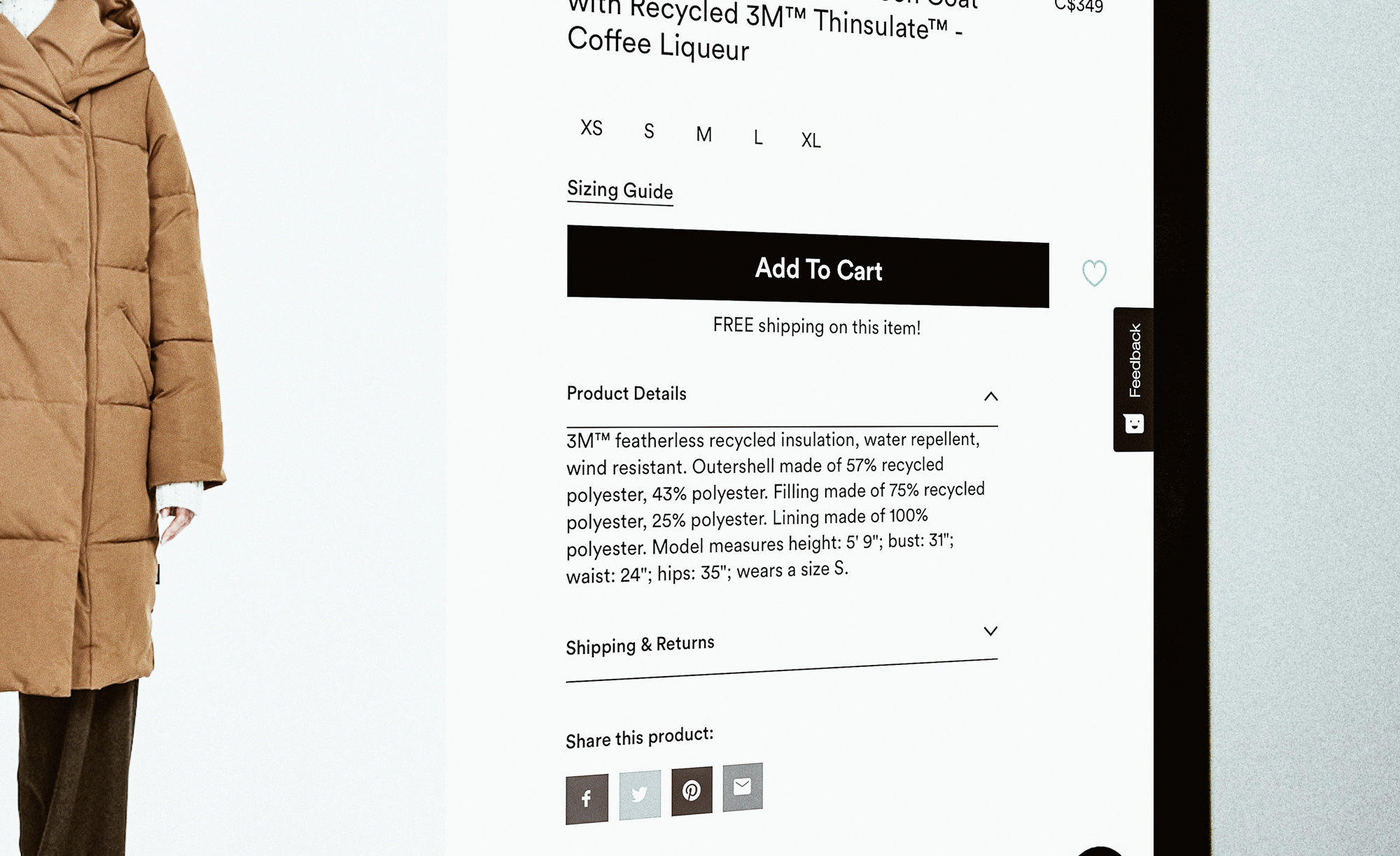
Insomma, avere uno shop online è ormai una opzione inevitabile per qualsiasi attività commerciale. Inoltre, secondo gli analisti, il settore del commercio online è quello che crescerà di più nell'economia mondiale, con un incremento calcolato fino al +55%.
Questo è infatti proprio il momento di attrezzarsi e di investire nelle tecnologie digitali e puntare appunto sulla trasformazione digitali. Adattare i propri servizi alla vendita online, è la mossa più intelligente da fare in questo momento storico.
Punti cardine di un e-commerce perfetto
Ormai già sappiamo che il consumatore online è molto più esigente e a volte più diffidente del classico cliente che ci viene a trovare in negozio. Tuttavia la soddisfazione dell’utente è uno dei cardini fondamentali di un buon e-commerce. L’affidabilità e la qualità del servizio, l’interfaccia user-friendly e l’assistenza al cliente sono punti fondamentali.
Non possono inoltre mancare un ottima comunicazione e gestione del marketing specifico per uno shop online. Japan Italy Bridge si occupa non solo di costruire e-commerce di alto livello ma anche di comunicare il vostro marchio online sulle varie piattaforme. Infatti, l’ottimizzazione SEO di un e-commerce e la brand awareness aiutano ad aumentare le vendite ma anche la percezione del marchio stesso da parte del cliente.
In particolare la comunicazione e il marketing sono l’ostacolo più alto da superare ma anche il punto focale per la portata di un e-commerce. Investire in traduzioni professionali e in un team che segua la parte di social e digital marketing aiutano a posizionare il vostro marchio sui motori di ricerca.
Quello che Japan Italy Bridge consiglia, è creare un sistema multicanale vi porterà ad avere un e-commerce vincente e ad aumentare le vostre vendite e i vostri ricavi. Non solo, potreste anche scoprire mercati che prima rimanevano ignorati dalla vostra azienda.

L’esperienza COVID ci ha insegnato che bisogna essere sempre pronti al cambiamento e a differenziare la presenza sulle piattaforme offline e online. Il modo e i mezzi di vendita sono drasticamente cambiati. Il mercato retail virtuale ha infatti ricevuto effetti dirompenti che nessuno fino a poco tempo fa avrebbe mai immaginato. Questo ha avuto un grosso impatto sull’economia e l’organizzazione di molte aziende. Al giorno d’oggi è infatti normale non solo ricevere il cibo da asporto a casa, ma anche altri tipi di materiali.
Dopo l’esperienza della pandemia è diventato fondamentale avere una presenza online. Se la vostra azienda è interessata a costruire un e-commerce o interfacciarsi con il pubblico digitale, potete contattarci e scoprire le offerte riguardo i nostri servizi.
Business Focus: Social Media durante e dopo la pandemia
I social media sono da tempo parte integrante della nostra vita, ma proprio durante questa pandemia mondiale, abbiamo scoperto quanto questo mezzo sia importante.
L’importanza dei Social Media in tempo di pandemia
Autore: Erika
La pandemia di COVID-19 ha stravolto completamente le nostre vite non solo a livello sanitario ma soprattutto nella nostra routine giornaliera. Se c’è qualcosa che abbiamo imparato da questa situazione, è che dobbiamo essere preparati a qualsiasi cosa ci riservi il futuro. Nessun obiettivo infatti è realistico, ma nei nostri piani dobbiamo cercare di avvicinarci il più possibile a quella che sarà la realtà.
Molti si stanno chiedendo come sarà il mondo post COVID-19 e trovare una risposta non è semplice. Tuttavia una cosa è certa, dobbiamo essere pronti a cambiare e aggiustare le nostre strategie di marketing in qualsiasi momento e il digital sembra essere la strada giusta per farlo.
In questo articolo, andremo a vedere come il COVID-19 ha influito sull’utilizzo dei social media da parte delle aziende.
Con il distanziamento sociale, il digital e i social media hanno avuto un impatto di notevole intensità. Infatti, abbiamo notati un boom non solo app di messaggistica e video chiamata, ma anche tutte quelle piattaforme che ci hanno concesso di poter effettuare eventi digitali.
Sia nella nostra vita privata, che in quella lavorativa, la nostra quotidianità è stata toccata e segnata dal cambiamento di molte abitudini. Tuttavia non tutte le conseguenze sono state negative.
La famosa digital transformation, che in Italia era in stallo, ha subito una notevole accelerata proprio grazie a questa situazione mondiale. Spinti dall’impossibilità di continuare con i vecchi metodi, anche i brand più ostinati si sono arresi all’evoluzione digitale della comunicazione.
Cambiano le strategia di social marketing

Le strategie di marketing infatti sono cambiate per adattarsi ai nuovi supporti e strumenti, ma in primis è cambiato il modo in cui le aziende comunicano e si rapportano con i clienti.
In questo periodo di pandemia, il pubblico ha cambiato le proprie esigenze e le aziende hanno dovuto imparare a relazionarsi in una maniera vantaggiosa. Proprio per questo molto aspetto legato al social media marketing sono cambiati in tempo di pandemia.
Passando molto più tempo in casa e bombardati da tutte queste news negative, il pubblico ha avvertito la necessità di sentirsi in qualche modo connesso con il mondo. E’ proprio questo uno degli aspetti fondamentali che ha permesso alle aziende di cogliere al volo le opportunità e le offerte legate alla digital transformation.
Per chi come noi si occupa di Marketing, avrà infatti notato che i tempi di pubblicazione dei post sono stati completamente stravolti. Il COVID-19 ha mescolato parecchio le carte in tavola e se prima si preferiva postare sui social durante in giorni specifici nella pausa pranzo, ora questo periodo si è esteso a tutti i giorni feriali. E’ invece passato in secondo piano quello che noi chiamiamo il “momento dei pendolari”, quindi dalle 17 in poi i social ora sono poco gettonati.
Invece, se prima il fine settimana risultava uno dei momenti peggiori per pubblicare, ora post lockdown la mattina del weekend è diventato uno dei momenti più ricercati.
I social media più visti durante la pandemia
Con il lockdown forzato, i programmi TV sospesi, telegiornali monopolizzati dalle news relative al Coronavirus, il pubblico ha disperatamente bisogno di intrattenimento. Questo ha fatto sì che il pubblico si riversasse sui social media, in particolare su Instagram, YouTube e TikTok alla ricerca di distrazione. Proprio per questo motivo è diventato ancora più fondamentale pubblicare con i tempi giusti.
Anche il volume dei messaggi inviati e ricevuti è cambiato. Nonostante per alcuni settori ci sia stato un calo di pubblicazione dei post, per altre aziende invece il volume è rimasto costante o addirittura è incrementato.
Infatti, alcune aziende hanno aumentato i messaggi rivolti al pubblico durante la pandemia. Per esempio, il settore dell’intrattenimento ha incrementato le proprie attività sui social proprio per offrire distrazione ai cittadini già distrutti dal distanziamento sociale.
Altre aziende invece legati ai settori dello sport e del turismo sono state particolarmente segnate dalla restrizione o sospensione di tutte le attività. Ed è proprio in questi settori dove si è registrato un calo nella comunicazione. Tuttavia questo è stato un passo errato da fare. Potrebbe sembrare la scelta più logica quella di tagliare i fondi legati alla comunicazione in un periodo di crisi come questo, ma in realtà è uno dei gesti più controproducenti che un’azienda possa fare. Ma di questo parleremo in uno dei nostri prossimi articoli.
I social media come strumento per connettere persone durante la pandemia


Sin dall’inizio di questo 2020, abbiamo visto come il nostro stile di vita sia cambiato completamente creando nuove regole per tutti.
Infatti, molte aziende si sono trovate a dover ricalibrare la propria strategia in luce dei fatti avvenuti. Ci siamo domandati molte volte se questo contenuto fosse adatto alla situazione attuale, e molte volte ci siamo trovati a rimuoverlo. In un periodo come questo dove la gente è particolarmente sensibile ad ogni tipo di messaggio, è molto importante controllare ciò che viene condiviso ma ancora più importante è adattarsi ad ogni situazione.
Ascoltare le richieste e i sentimenti dei vostri clienti e identificare le loro esigenze è fondamentale al giorno d’oggi per poter capire come orientare la vostra strategia. La pandemia ha creato un clima di terrore generale e per tale motivo ora il pubblico è alla ricerca di conversazioni positive. La gente si è stufata della negatività e di tutto questo sentimento di preoccupazione legato al COVID19 e cerca distrazione sul social.
A marzo sono aumentati del 1.174% i messaggi che avevano come temi aiutare il prossimo, culminando in 19,5 milioni di messaggi nel corso del mese. In questo periodo ricco di insicurezze, le persone cercano più che mai di connettersi e sostenersi l’un l’altro. I social media sono diventati l’epicentro di questo movimento.
Nel sondaggio #BrandsGetReal di SproutSocial del 2019, è stato individuato che il 91% degli intervistati crede che i social network abbiano il potere di connettere le persone, di cui il 78% vorrebbe che i brand utilizzassero i social network per farli incontrare. Questo sentimento è diventato ancora più forte dopo l’avvento della pandemia.
Riuscire a capire cosa il tuo pubblico desidera e dimostrare loro che la vostra azienda ha capito questo bisogno, è la soluzione migliore per una buona comunicazione anche in questo strano 2020.
Business Focus: Lo strambo mondo del web design giapponese
Vi siete mai chiesti perchè il web design giapponese è così diversi rispetto a quello in occidente?
Lo strambo mondo del web design giapponese
Autore: Erika
Japan Italy Bridge si occupa di offrire servizi per le aziende e parte del nostro lavoro è creare siti web. “Che novità” potreste dire, sì perchè ci sono tante agenzie come noi, ma cosa ci differenzia dalle altre? Beh noi abbiamo la capacità di adattare lo stile e il visual giapponese a quello occidentale e viceversa.
E’ molto molto importante per ogni azienda avere un sito internet che la rappresenti. Tuttavia, spesso capita che lo stile e il design che utilizziamo in Italia non sia propriamente adatto per il linguaggio e il popolo giapponese.
Infatti, se analizziamo anche solo visivamente i siti giapponesi, le differenze saltano subito all’occhio.

Come ben sappiamo, nella maggior parte del mondo occidentale, i siti internet hanno un layout semplice. Infatti, rispetto ai primi anni 200, abbiamo sostituito la miriade di link con un contenuto rilevante e conciso che ci porti velocemente al nostro scopo.
Tuttavia, in Giappone esiste una diversa cultura anche a livello di gusto visual. Infatti, parte dei siti internet sono cambiati pochissimo rispetto ai primi anni 2000. A tal proposito, possiamo proprio vedere come diversi siti siano sovraccarichi di link e informazioni. Questo per un occhio occidentale è totalmente inconcepibile, mentre diventa la norma per un occhio giapponese.
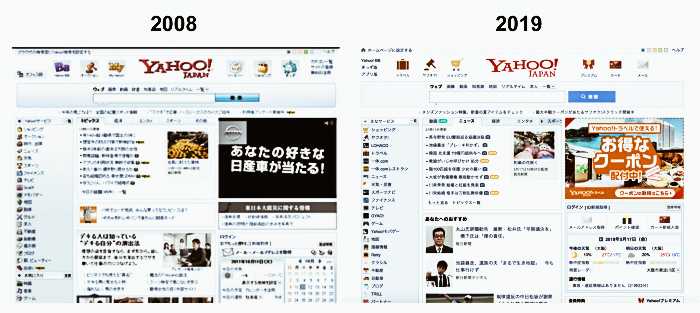
Yahoo era uno dei motori di ricerca più popolari di tutto il Giappone e lo è ancora per tante homepage. Tuttavia, come potete vedere dalle foto, il suo design e layout sono cambiati veramente pochissimo negli ultimi 10 anni
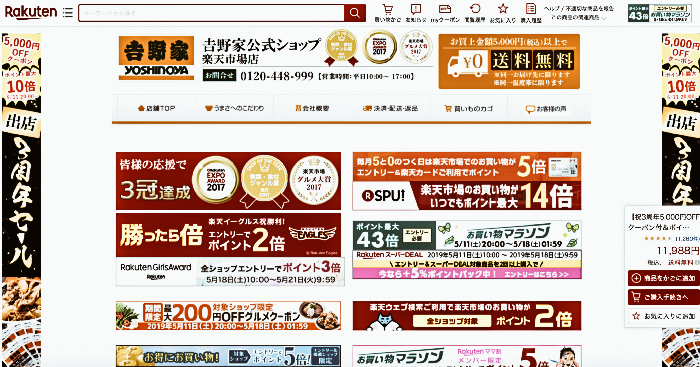
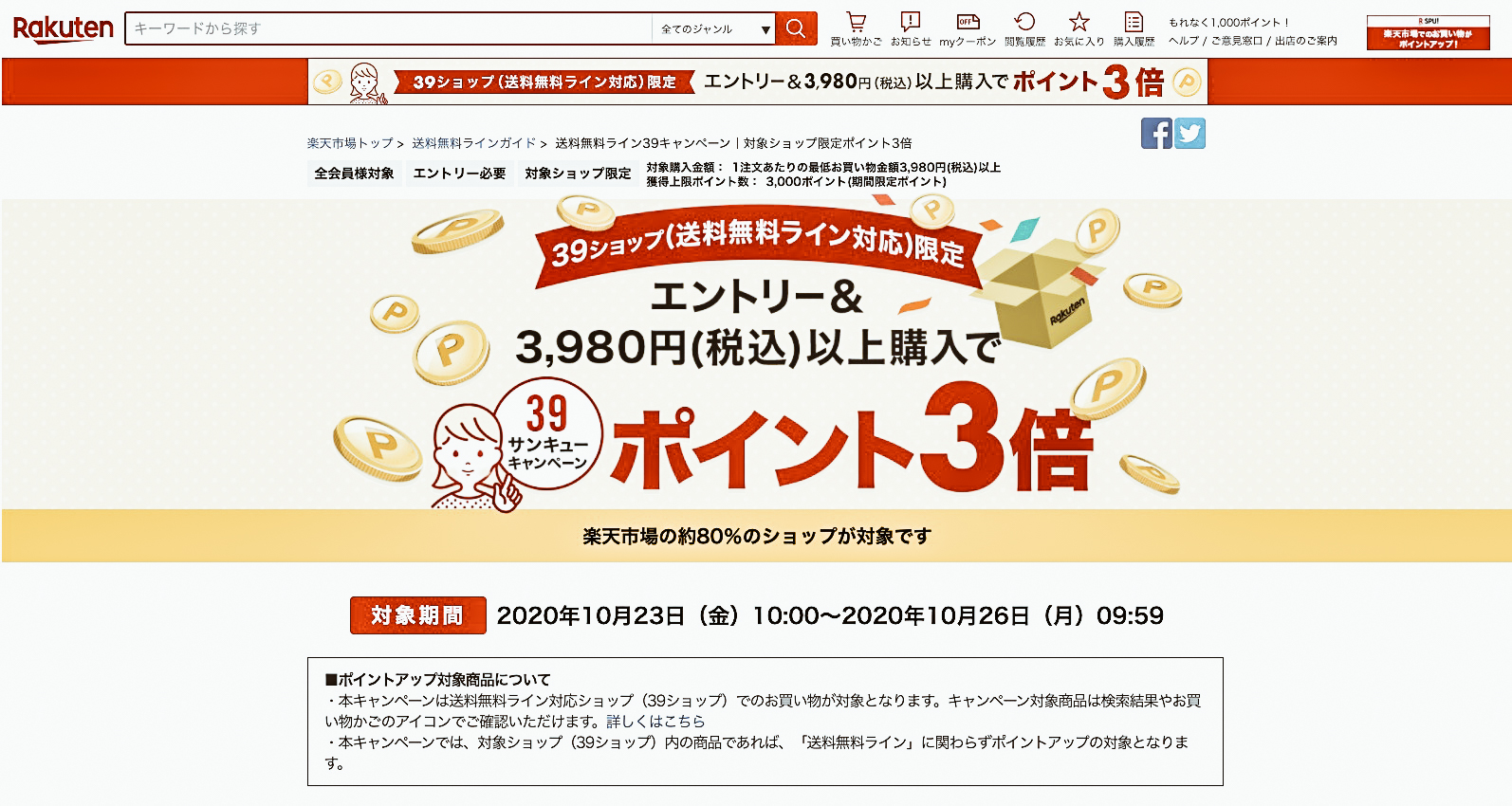
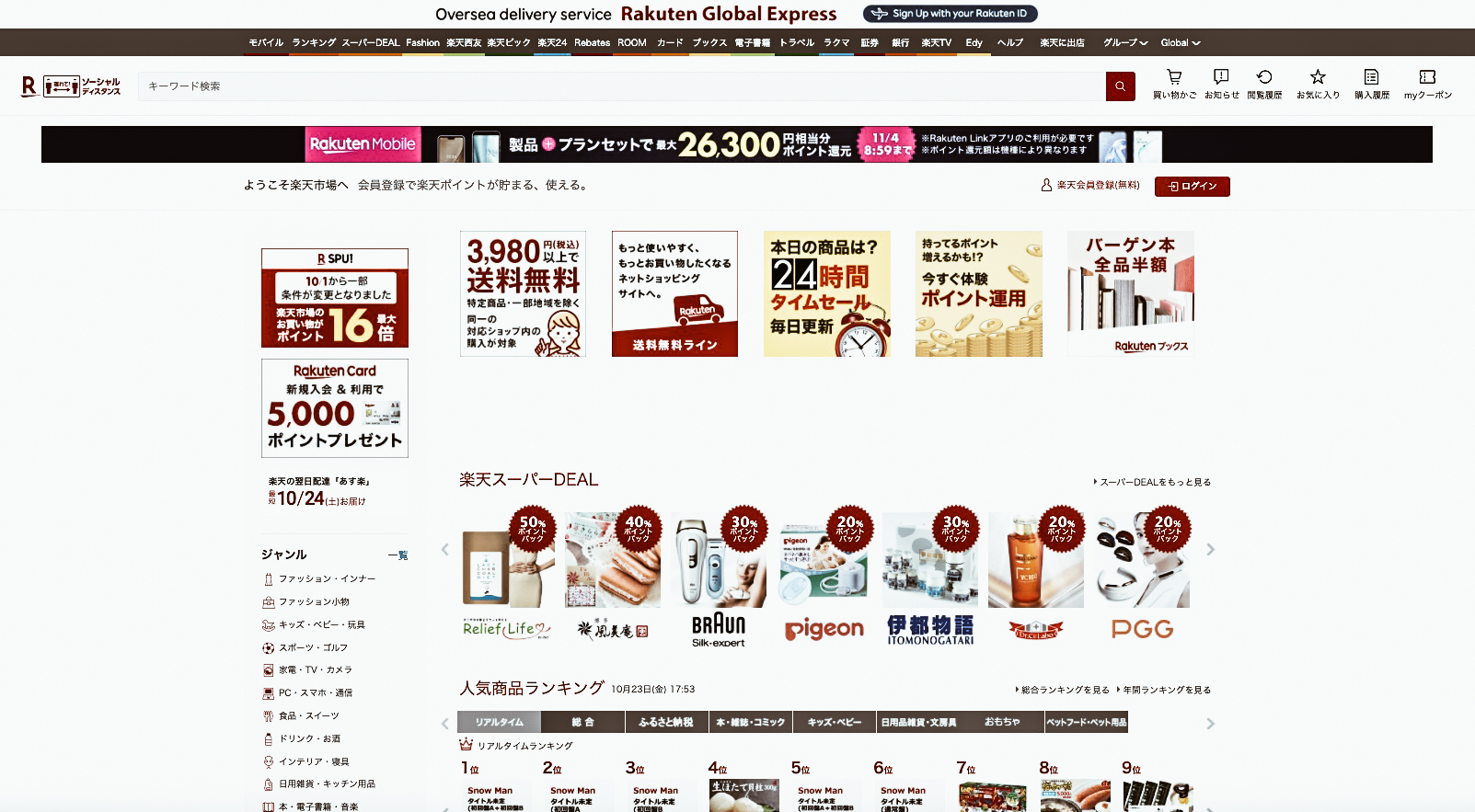
Un’altro esempio è la homepage di Rakuten, il centro commerciale online più grande della nazione.
Rakuten è un po’ l’Amazon dell’Asia e ogni negoziante può personalizzare la propria pagina. Questo risulta in un grande display di varie immagini, banner e pop up su diverse pagine che a volte hanno anche bisogno di lungo tempo per essere scrollate.
Perchè il Web Design giapponese è così?
Ma eccoci alla vera questione, perché il web design in Giappone deve seguire questi determinati canoni di stile? La risposta è semplice. La maggior parte del popolo nipponico è formato da utenti anziani che preferiscono mantenere la tradizione. Questo succede anche nello stile visual di come i siti internet vengono costruiti e vissuti.
Questo rende complicato per le aziende un cambiamento verso uno stile che potremmo definire più internazionale.
Inoltre, la maggior parte degli utenti giapponesi utilizza internet tramite un supporto desktop e non mobile. Quindi anche i maggiori siti internet tendono a mantenere il design corrente, anche per non confondere lo user finale.
Un altro motivo per cui i giapponesi preferiscono questo stile che noi definiremmo “vecchio” è anche per la loro cultura dell’informazione. Infatti, se siete mai stati in Giappone o se vi è mai capitato di vedere alcune immagini del paese, avrete notato che le insegne sono onnipresenti. I giapponesi sono bombardati dai neon luminosi e dalle insegne che raccontano di negozi, offerte speciali e occasioni da non perdere. Questo si traspone anche sui siti internet dove il popolo giapponese preferisce avere tutte le informazioni subito.
Il Caso LINE
Quando l’app di messaggistica LINE (il corrispettivo giapponese di Whatsapp) ha deciso di cambiare e semplificare il layout della loro homepage, il popolo giapponese non l’ha presa benissimo. Infatti, proprio in quel periodo, gli utenti si sono scatenati con review da una stella e con numerose richieste all’azienda di cambiare al vecchio design.
Cambiamento all’orizzonte
Tuttavia, nonostante la preferenza per un approccio più tradizionale, alcune giovani fra i 20 e 30 anni hanno dichiarato di preferire un design più minimal.
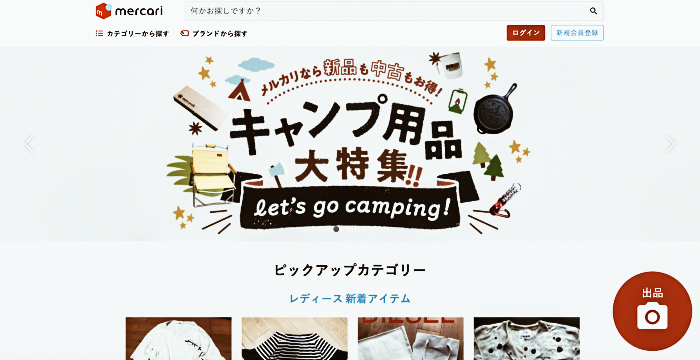
Il caso Mercari ne è infatti un esempio. Stiamo infatti parlando di un sito che offre servizi di aste online con un’interfaccia semplice e user friendly. In poco tempo, Mercari ha preso il sopravvento su Yahoo Auctions, l’app più quotata in Giappone per questi servizi.
La storia di questo brand ha messo luce sull’importanza di un buon layout UX, incoraggiando i giapponesi ad assumere nuovi designer in procinto del cambiamento.
Le ditte giapponesi dovranno cominciare ad adattarsi ad un design più moderno non solo per risultare più interessanti per un pubblico più giovane ma anche per diventare più competitive a livello internazionale.
Se vi è piaciuto questo e gli altri nostri articoli, unitevi alla nostra newsletter per ricevere update esclusive e tanti nuovi articoli.
Business Focus: Influencer Marketing in Giappone, 5 cose da sapere
Abbiamo tutti sentito parlare di Influencer Marketing ma quali sono le differenze in Giappone?
Japan Italy Bridge si occupa di offrire servizi alle aziende nel campo del Digital Marketing e degli eventi. Molte aziende italiane che hanno richiesto i nostri servizi di promozione verso il mercato giapponese, ci hanno domandato quali siano le differenze fra le due nazioni per quanto riguarda l’Influencer Marketing.
Influencer Marketing in Giappone: 5 cose da sapere
Autore: Erika
Per chi non sappia cosa sia l’Influencer Marketing, stiamo parlando di un ramo della promozione che usufruisce dell’utilizzo di bloggers ed influencer con un target specifico di pubblico.
Al giorno d’oggi, questa strategia è uno dei metodi più efficaci in gran parte dei mercati, questo vale anche per quello giapponese. Infatti, l’Influencer Marketing in Giappone gioca un grosso ruolo ma le regole sono diverse rispetto alle nazioni occidentali.
Oggi condividiamo con voi 5 differenze per aiutarvi capire meglio.

La barriera Linguistica
Uno degli aspetti dei social media giapponesi e quindi anche dell’Influencer Marketing, è che tutto deve essere fatto nella loro lingua. Purtroppo, il Giappone è posizionato 49° fra le 88 nazioni e regioni nella classifica dello studio e conoscenza della lingua Inglese. Una scarsa competenza se pensiamo a quanto i giapponesi usano il mezzo social media per informarsi e comunicare.
Proprio a causa di questo, i classici influencer globali come possono essere Chiara Ferragni, Cameron Dallas e altri, non sono così influenti come lo sono in altre nazioni abituate alla lingua inglese. Infatti, a volte risultano quasi sconosciuti rispetto anche a influencer locali con molti meno followers.
Questo porta ad un grosso dilemma per le aziende, utilizzare influencer locali o ignorare completamente il mercato giapponese. E’ vero, il mercato giapponese ora non è così remunerativo come quello cinese. Tuttavia, il Giappone è classificato 3° nella classifica mondiale GDP e questo è un dato troppo importante per ignorare completamente questa nazione e il suo valore di acquisto.
Come detto prima, è vero, gli Influencer giapponesi hanno meno followers rispetto a quelli globali. Tuttavia, proprio perché parlano in una lingua strettamente legata alla cultura del Sol Levante, questo li porta a non avere molti seguaci nel resto del mondo.
Quello che però possiamo capire da questi dati, è che in questo caso l’engagement diventa estremamente importante. Infatti, gli influencers giapponesi sono estremamente più legati al loro pubblico e le interazioni superano di gran lunga quelle occidentali.
Gli hashtag giapponesi richiedono un background culturale
Quando un’azienda lavora col Giappone, deve capire l’unicità di questo paese e della sua cultura. E’ importante quindi lavorare su hashtag corretti e usarli propriamente. Questo ci porterà a trovare la community in target da poter approcciare e riuscire ad ottenere un ritorno sul nostro investimento.
Gli Influencer e i micro-influencer possono essere trovati utilizzando gli hashtag. Tuttavia trovare il corretto hashtag giapponese non è così facile per coloro che non parlano la lingua e non conoscono la cultura. Inoltre, molto spesso, gli hashtag più diffusi sono appunto dei neologismi.
Per esempio #インク沼 è la traduzione diretta di “Palude di inchiostro senza fondo”. Apparentemente tutto ciò non ha alcun senso, se non fosse che “Qualcosa senza fondo” è uno slang internet usato molto dai giapponesi per descrivere quando qualcuno è davvero appassionato di qualcosa. Tuttavia se togliamo il background culturale, questo hashtag perde completamente di significato.



photo credits: @v_sarasara, @tommy_notes_16 , @mizuki___iz
Inoltre, spesso gli hashtag giapponesi possono risultare molto complicati da capire per un occhio occidentale. Questo succede a causa dei tre modi di scrivere la lingua, ovvero il mix di Kanji, Hiragana e Katakana.
Quindi quando usiamo gli hashtag giapponesi, dobbiamo stare attenti a come questi vengono scritti perché la combinazione dei tre modi può portare un significato differente. Nel linguaggio di internet, un hashtag scritto in modo diverso porta anche diversi risultati a livello di numero di pubblico. Infatti questo può influire sul numero di persone che potremmo andare a raggiungere.
Gli Influencer in Giappone sono distribuiti su diverse piattaforme
Anche in occidente, è raro che un influencer abbia la stessa forza su tutte le più popolari piattaforme social. Molti sono popolari solo su Instagram, altri solo su Tik Tok o Twitter. Questo ha ancora più effetto in Giappone con anche la presenza di alcune piattaforme specifiche per la cultura nipponica. Ad esempio, abbiamo NewsPicks che si interfaccia con un pubblico prettamente corporate. Mentre note è un social dedicato interamente ai creatori di contenuti come racconti, tutorial, blog giornalistici e soprattutto manga.
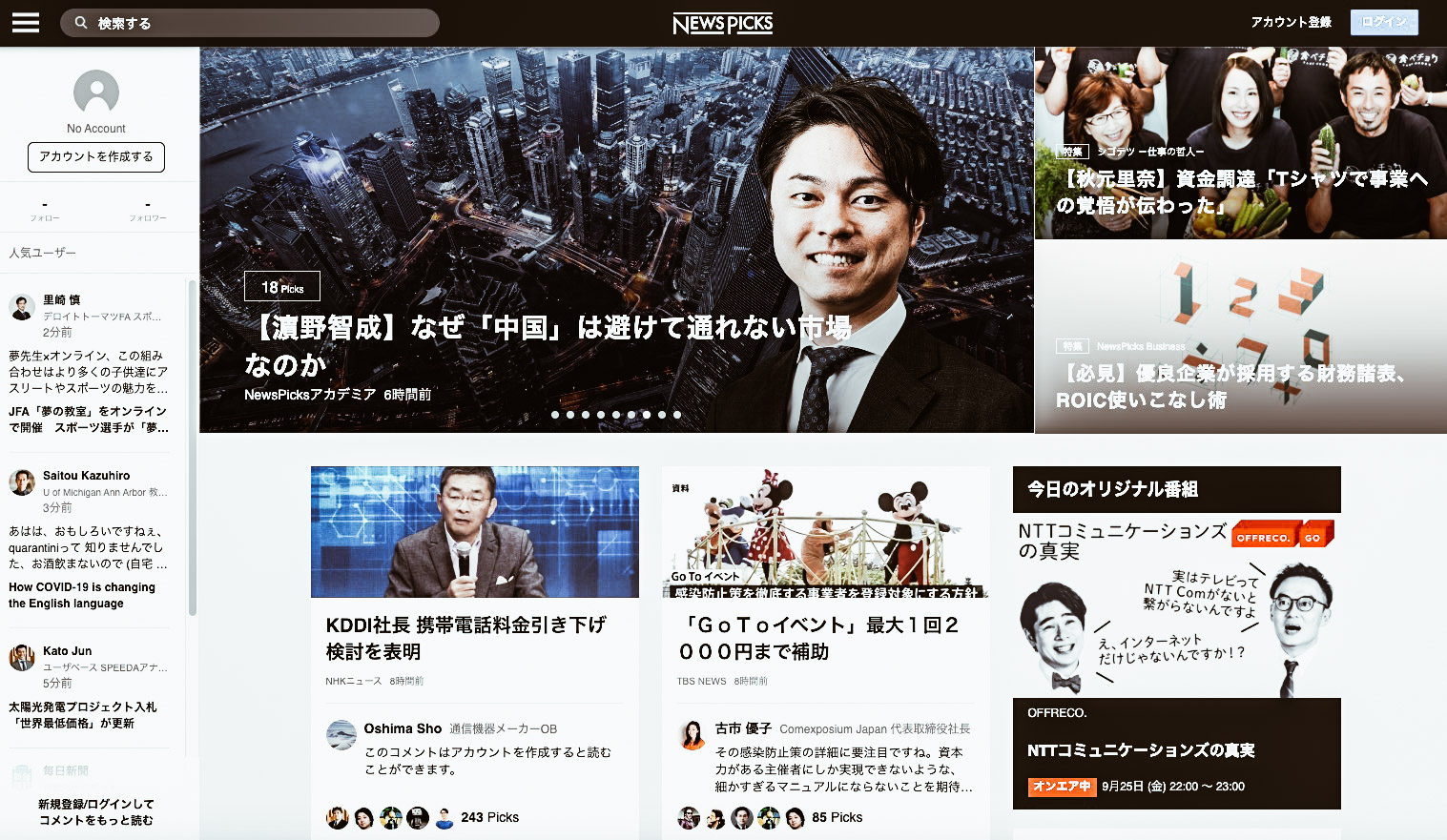
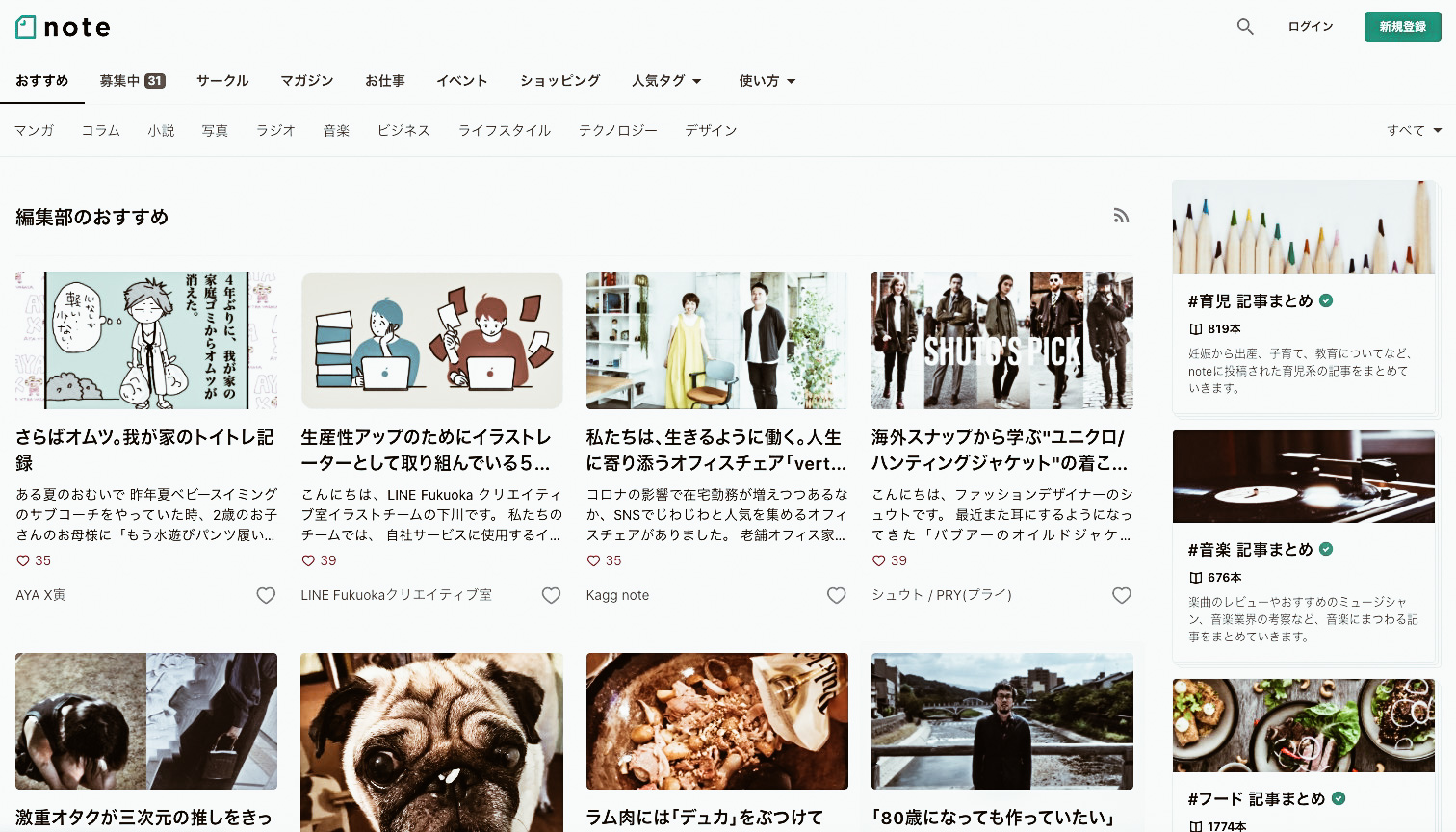
I top Influencers e le agenzie
Come capita anche per l’occidente, molti influencer giapponesi quando cominciano a diventare popolari vengono seguiti da alcune agenzie. Al momento, purtroppo, ci sono pochi influencer che lavorano in modo “freelance”. Quindi, se si vuole lavorare con un influencer che appartiene ad un’agenzia, si deve per forza passare tramite questa.
Tutto ciò comporta dei pro e contro.
Pro
- Accesso ai maggiori influencer
- Si risparmia tempo nel trovare il giusto influencer visto che le agenzie come la nostra coprono questa parte di lavoro per voi
- L’agenzia si occupa di negoziare i contratti e i compensi
In questo caso, il lavoro dell’agenzia diventa quindi un beneficio per l’azienda che si ritrova ad avere un lavoro calcolato su misura per i proprio interessi.
Contro
- Costi superiori
- Minor flessibilità
- I contatti diretti degli influencer rimangono privati
Purtroppo, usando un’agenzia bisogna sottostare alle regole della stessa e queste variano da agenzia ad agenzia.
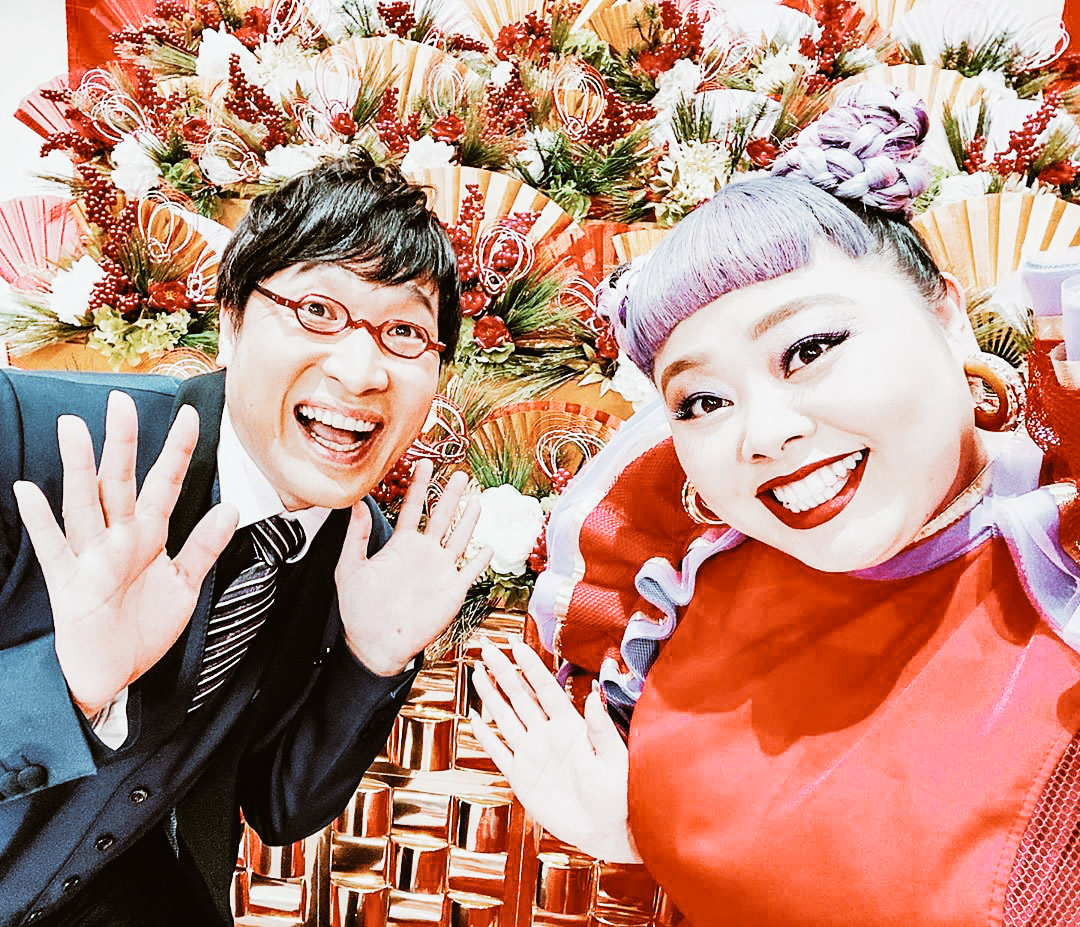

photo credits: @watanabenaomi703 , @rolaofficial
Post pagati in sordina
Il popolo giapponese è molto severo quando si tratta di onestà e trasparenza. Questa severità viene applicata anche nell'Influencer Marketing in Giappone. Infatti, quando i post a pagamento degli influencer non segnalati come tali, tendono ad essere ignorati dal pubblico e a dare una cattiva impressione.
Tuttavia, non ci sono leggi dirette che regolano la trasparenza di un post sponsorizzato da un Influencer in Giappone. Inoltre, non tutti gli influencer sono a conoscenza del modo giusto di comunicare una partnership.
Per un’azienda, è quindi molto importante educare gli influencer scelti e non lavorare in modo casuale pur di ottenere impressions.
In occidente ormai abbiamo delle linee guida ben definite sull’utilizzo delle sponsorizzazioni tramite Influencer Marketing e queste dovrebbero servire anche per collaborazioni con Influencer giapponesi.
Se vi è piaciuto questo e gli altri nostri articoli, unitevi alla nostra newsletter per ricevere update esclusive e tanti nuovi articoli.
Festival delle Lucciole di Nagano
Con l'avvento del COVID-19, molti eventi sono stati cancellati in tutto il mondo, ma il festival delle lucciole in Giappone non si ferma e quest'anno gli insetti luminosi danzano da soli.
La danza solitaria del festival delle lucciole nel 2020
Autore: Erika | Fonte: Japan Times
E' un momento magico quando a Tatsuno, nella prefettura di Nagano, il sole tramonta e migliaia di lucciole cominciano a danzare e brillare, creando così uno spettacolo unico. Solitamente, questo evento porta folle di visitatori nella città, tuttavia a causa dell'epidemia da coronavirus, quest'anno agli spettatori non è concesso assistere a questo evento.
Infatti, in questo strambo 2020, la danza degli insetti incandescenti si svolge senza spettatori poiché l'evento è stato annullato. Ciò nonostante, anche se molti fan sono rimasti delusi, si è creata un'atmosfera insolitamente serena e unica. Gli insetti infatti non si fermano e continuano a lampeggiare, spegnendosi e accendendosi, danzando nell'aria notturna. Uno spettacolo naturale che dura solo 10 giorni all'inizio dell'estate che segna l'ultimo capitolo della vita di una lucciola.
Katsunori Funaki dice che "L'incandescente è il comportamento di corteggiamento delle lucciole. Esse brillano per comunicare tra il maschio e la femmina. Durante il breve periodo di 10 giorni, trovano un compagno e depongono le uova per l'anno successivo".

Insomma, il festival delle lucciole è un vero e proprio appuntamento da non perdere. Infatti, più di 30.000 compiono questa magia durante quei 10 giorni a Tatsuno, al centro della prefettura di Nagano. Il sindato Yasuo Takei dice "Le testimonianze storiche dicono che un numero enorme di lucciole è stato visto lungo il fiume Tenryu tra la fine del 19° e l'inizio del 20° secolo". Queste piccole creature erano quasi estinte nella zona a causa della forte produzione delle industrie di seta che creavano inquinamento.
Tuttavia, dopo la Seconda Guerra Mondiale, la città ha lavorato duramente per ricreare e ripristinare l'ambiete adatto per proteggere le lucciole che ora attirano migliaia di visitatori durante l'annuale festival estivo. "Quando abbiamo molte lucciole, otteniamo un paesaggio spettacolare pieno di luci, con sia le stelle che le lucciole che brillano riflesse nell'acqua", ha detto Takei. Un evento e un panorama assolutamente unico nel suo genere.

Proprio per la forte importanza che ha questo festival, la città ha creato un parco con fossati per portare l'acqua dolce dal fiume, con cascate e una casa acquatica ricca di ossigeno per gli insetti.
I festival delle lucciole vanno in scena dalla fine di giugno in molte parti del Giappone e questo rito di corteggiamento luminoso è celebrato vivamente in tutto il paese.
"Le lucciole sono creature che crescono per oltre un anno e volano per soli 10 giorni per lasciare la generazione successiva prima di morire", ha detto l'organizzatore del festival. "Vogliamo prenderci cura di loro in modo che lascino le uova per il prossimo anno e vedremo ancora una volta le lucciole danzare meravigliosamente".
Shinrin-yoku, il bagno di foresta
Lo Shinrin-yoku tanto amato dai giapponesi è quello che noi italiani chiamiamo "bagno di foresta" e può essere curativo e rigenerante. Questa pratica, il cui maggior esponente è il dottor Qing Li della Nippon Medical School di Tokyo, sta diventando molto famosa anche qui in occidente. Ma vediamo in dettagli di cosa si tratta.
Shinrin-yoku, il bagno di foresta amato dai giapponesi
Autore: Erika | Fonte: Tokyo Weekender

Una delle più grandi tendenze healthy in testa alle classifiche di tutto il mondo, lo Shinrin-yoku è ormai diventato famoso internazionalmente. Tuttavia, la sua diffusione risale alla fine degli anni Ottanta in Giappone. Infatti, il Forest Bathing (bagno di foresta) è da anni considerata una vera e propria pratica di medicina preventiva nella terra del Sol Levante. a supporto di questo, esistono numerose ricerche condotte in tutto il mondo che hanno dimostrato come trascorrere regolarmente periodi immersi nella quiete dei bosci aiuti a rafforzare le difese immunitare e prevenire malattie. Ma di cosa si tratta esattamente?
Cos'è lo Shinrin-yoku, Forest Bathing?
Letteralmente, Shinrin-yoku (森林浴) unisce i kanji di "foresta" e "bagno", ed è comunemente tradotto come "bagno nella foresta". Promosso una quarantina di anni fa dal governo giapponese, lo Shinrin-yoku consiste nel passeggiare nei boschi e applicare particolare tecniche di respirazione. Tuttavia, le attività di foresth bathing non si limitano solo alla respirazione. Infatti, sia che ci si mantenga attivi o semplicemente si decida di prendersi del tempo di relax nell'area boschiva, anche questo riporta al forest bathing.
Usato per la prima volta nel 1982, questo termine è stato promosso dal Ministero dell'Agricolutra, delle Foreste e della Pesca giapponese per incoraggiare stili di vita sani, oltre che proteggere i bellissimi ambienti naturali della nazione. Dal 1986, l'Agenzia Forsetale insieme alla Green Civilization Society ha indicato più di 100 aree in tutto il Giappone dove è possibile questo concetto di balneazione. Ancora oggi, ci sono varie tecniche per mantenersi in salute, ma il forest bathing è uno di quei concetti che si sposa benissimo con l'ideologia giapponese.
All'inizio degli anni 2000, diverse università e centri di ricerca hanno condotto esperimenti per scoprire quanto questa pratica fosse efficace. I vari studi risultano unanimemente positivi. Infatti è stato dimostrato come passare del tempo fra gli alberi riduca lo stress, migliori l'umore, abbassi la frequenza delle pulsazioni e la pressione sangugna. Ma non solo, aumenta anche la concentrazione e la creatività insieme a rafforzare il nostro sistema immunitario.
La forse sensibilità e in particolare il profondo rispetto spirituale e storico per il mondo naturale, ha fatto sì che questa pratica fiorisse vivamente in questa nazione.

Il Forest Bathing diventa internazionale
A seguito del forte successo ottenuto in Giappone (circa 5 milioni di persone praticano lo Shinrin-yoku nella sola nazione), il forest bathing ha ottenuto una grande diffusione anche a livello internazionale. Oggi infatti ha molti adepti anche in Occidente, la stessa Duchessa di Cambridge ne è una fan, come riporta il The Guardian. A questo proposito, in Inghilterra molte istituzioni stanno proprio promuovendo questa pratica come sistema per allentare lo stress quotidiano.
Uno dei maggiori esponenti in materia, Quing Li, presidente della Società di Forest Medicine in Giappone e autore del libro Shinrin-Yoku: The Art and Science of Forest Bathing ha commentanto:
“Lo Shirin-yoku è a tutti gli effetti una medicina preventiva. La gente trascorre la maggior parte della propria vita in ambienti chiusi. Nel caso dei giapponesi si tratta dell’80% del tempo, e nel caso degli americani addirittura del 90%. Ma l’uomo è fatto per vivere all’aperto. Noi siamo stati progettati per essere connessi al mondo della natura”.
Dove provare lo Shinrin-yoku
Il forest bathing è un'attività poco impegnativa e anche poco costosa. Infatti, si può fare in qualsiasi momento, qualsiasi condizione metereologica e non richiede una particolare attrezzatura, nè forma fisica. Potete costruire la vostra esperienza su misura e a seconda delle vostre necessità.
In Giappone, la Forest Therapy Society è un'organizzazione senza scopo di lucro che identifica le aree con boschi e strade pedonali che sono state valutate scientificamente. Qui infatti troverete un "effetto bagno nel bosco" certificato. Attualmente in Giappone sono state certificate 62 aree, ognuna delle quali offre "strade per la terapia della foresta" con ampi sentieri di accesso adatti a passeggiate tranquille, alcune anche accessibili a sedie a rotelle.
In Italia, troviamo diverse mete attrezzate per i bagni di foresta, primi fra tutti il Trentino Alto Adige. Infatti, sull'altopiano del Renon e a Fai della Paganella, troviamo guide naturalistiche specializzate in "escursioni balance" e un "Parco del Respiro". Proprio questa regione, negli ultimi hanno ha puntato molto sulle esperienze full immersion nella natura, incluso il forest bathing.
Ma non solo, anche in Piemonte all'interno dell'Oasi Zegna, troviamo tre sentieri dedicati proprio al bagno nella foresta, percorsi unici nel loro genere in tutta Europa.








